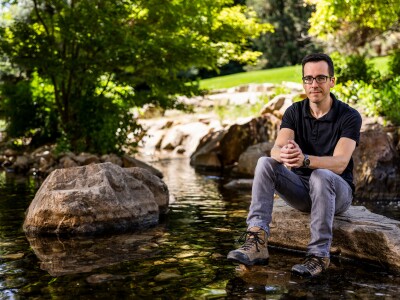The cloth masks many are sporting these days offer some protection against COVID-19. However, they typically provide much less than the professional N95 masks used by healthcare workers.
That may soon change. Recently, students from BYU’s College of Engineering teamed up with Nanos Foundation to develop a nanofiber membrane that can be sandwiched between the cloth pieces in a homemade mask.
While today’s typical cloth mask might block fewer than 50% of virus particles, the membrane — which can be made using simple, inexpensive materials — will be able to block 90 to 99% of particles, increasing effectiveness while preserving breathability.
The membranes are made through a process called “electrospinning,” which involves dissolving a polymer plastic in a solution and then using an electrical current to move a droplet of the polymer downward through a needle. As the droplet accelerates, it stretches into a very small fiber that retains a static charge.
“Those nanofibers randomly land on a collector to create a sort of non-woven mesh,” said Katie Varela, a BYU mechanical engineering senior on the project team.
The remaining charge in the fibers is beneficial, she explained, because virus particles also have a static charge. “When they come close to your mask, they will be statically attracted to the mask and will not be able to go through it, and so it prevents you from inhaling viruses.”

In addition to the dramatic improvement in efficacy, another key benefit of the nanofiber masks is that unlike traditional N95 masks, which have a reputation for being hot and stuffy, they allow for the circulation of (filtered) air, water and heat.
“Not only is it hard to find an N95 mask these days, but the best mask is useless if you won’t wear it,” said Will Vahle, director at Nanos Foundation. “Our nanofiber membranes are six times easier to breathe through than existing N95 masks, making them cooler, drier, and more comfortable.”
The group plans to make the instructions for creating the membranes open source. They hope that non-profit organizations will use the instructions to set up local sites where people can bring in their masks to be fitted with a membrane. They also hope other engineers will use their work as a springboard to produce more effective filters.
“We had our own proprietary nanofiber production process,” said Vahle of the project’s origins, “but we realized, hey, we have some expertise in this — why don’t we get this together and release a version that anybody can do?”
When Vahle and his colleagues approached BYU to collaborate on the project, BYU “jumped at the opportunity,” Vahle said. In addition to providing funding and facilities, the university connected the company with “fantastic students, who’ve really demonstrated an incredible work ethic and a drive to help people in need.”
Using cutting-edge science to make an immediate positive impact has also been highly valuable for the BYU students on the project.
“This experience makes things very real,” said Varela. “I’m really glad that I’m able to help with this fight against COVID-19 to help people all around the world and in my community.”





